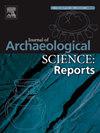Decorated bone artefacts in Southern Patagonian Hunter-Gatherer locality Cerro Casa de Piedra (Santa Cruz, Argentina)
IF 1.5
2区 历史学
0 ARCHAEOLOGY
引用次数: 0
Abstract
This paper studies portable art in continental Patagonia, specifically decorated bone artefacts from the archaeological locality known as Cerro Casa de Piedra (CCP), located in the Province of Santa Cruz (Argentina). The artefacts analysed, retrieved from two rock shelters within CCP (sites 5 and 7), make up a rare assemblage, with varied chronologies, diverse decorations, and the highest concentration in the area for this type of objects. In order to characterise this portable art, two aspects were considered: the type of decoration and the particularities of the bone used as surface (species and anatomical part). The set consists of painted and carved decorations elaborated primarily on guanaco (Lama guanicoe) and huemul (Hippocamelus bisulcus), the same species on which the diet of these hunter-gatherer groups was based. It was possible to observe specific patterns in the choice of decorations for particular anatomical parts. Differences in the level of precision and detail in these decorations, as well as the degree of skill required, also suggested that more time and effort were dedicated in the elaboration of decorations in artefacts made between ca. 9600 to 7900 years BP, compared to those made after ca. 6500 years BP. Rock art and portable art in CCP show strong differences in designs chosen and techniques used, which suggests that these visual platforms account for distinct dynamics regarding the circulation of visual information using different codes. This study offers new insight on Patagonian portable art, and provides valuable and rare information on communication in hunter-gatherer groups in the area.
南巴塔哥尼亚狩猎-采集地点 Cerro Casa de Piedra(阿根廷圣克鲁斯)的装饰骨器
本文研究巴塔哥尼亚大陆的便携式艺术品,特别是位于圣克鲁斯省(阿根廷)的 Cerro Casa de Piedra(CCP)考古地点出土的装饰骨器。所分析的文物取自 CCP 内的两个岩洞(5 号和 7 号遗址),是一个罕见的集合体,年代各异,装饰多样,是该地区此类文物最集中的地方。为了确定这些便携式艺术品的特征,我们考虑了两个方面:装饰类型和用作表面的骨头的特殊性(种类和解剖部位)。这套艺术品包括彩绘和雕刻的装饰,主要是在瓜纳科(Lama guanicoe)和胡埃穆尔(Hippocamelus bisulcus)上精心制作的,而这些物种正是这些狩猎采集群体的主要食物。在选择特定解剖部位的装饰物时,可以观察到一些特定的模式。这些装饰在精确度和细节方面的差异以及所需的技能程度也表明,与约公元前 6500 年之后制作的文物相比,约公元前 9600 年至 7900 年之间制作的文物在装饰的制作方面花费了更多的时间和精力。中太平洋地区的岩石艺术和便携式艺术巴塔哥尼亚文化中心的岩石艺术和便携式艺术在选择的设计和使用的技术方面表现出很大的差异,这表明这些视觉平台在使用不同的代码进行视觉信息传播方面具有独特的动力。这项研究为巴塔哥尼亚便携式艺术提供了新的视角,并为该地区狩猎采集群体的交流提供了宝贵而罕见的信息。
本文章由计算机程序翻译,如有差异,请以英文原文为准。
求助全文
约1分钟内获得全文
求助全文
来源期刊

Journal of Archaeological Science-Reports
ARCHAEOLOGY-
CiteScore
3.10
自引率
12.50%
发文量
405
期刊介绍:
Journal of Archaeological Science: Reports is aimed at archaeologists and scientists engaged with the application of scientific techniques and methodologies to all areas of archaeology. The journal focuses on the results of the application of scientific methods to archaeological problems and debates. It will provide a forum for reviews and scientific debate of issues in scientific archaeology and their impact in the wider subject. Journal of Archaeological Science: Reports will publish papers of excellent archaeological science, with regional or wider interest. This will include case studies, reviews and short papers where an established scientific technique sheds light on archaeological questions and debates.
 求助内容:
求助内容: 应助结果提醒方式:
应助结果提醒方式:


